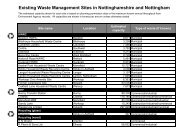Nottinghamshire Common Assessment Framework Handbook
Nottinghamshire Common Assessment Framework Handbook
Nottinghamshire Common Assessment Framework Handbook
You also want an ePaper? Increase the reach of your titles
YUMPU automatically turns print PDFs into web optimized ePapers that Google loves.
Learning<br />
Understanding, reasoning and problem solving: The ability to understand and organise information, reason and solve<br />
problems. How well for their age the infant, child or young person is able to understand and organise information, reason<br />
and solve problems.<br />
Participation in learning, education and employment: The degree to which a child or young person has access to and is<br />
engaged in education and/or work based training and, if he/she is not participating, the reason for this. How far the<br />
infant, child or young person is engaged in and attending learning appropriate to their age, whether through play, early<br />
years settings, school or college/employment.<br />
Progress and achievement in learning: The child or young person’s educational achievements and progress, including in<br />
relation to their peers. The infant, child or young person’s educational achievements and progress, including ability to<br />
read and write, compared with what would normally be expected from someone of their age.<br />
Aspirations: The ambition of the child or young person, whether their aspirations are realistic and they are able to plan how<br />
to meet them. Note there may be barriers to a child or young person’s achievement of their aspirations, for example the<br />
child or young person’s other responsibilities in the home.<br />
Basic care, ensuring safety and protection<br />
Parents and Carers<br />
The extent to which an infant, child or young person’s physical needs are met and they are protected from harm or<br />
danger, including self-harm. How far the infant, child or young person is safe from harm or sexual exploitation, is well-fed<br />
and cared for, and living in a safe, warm and clean home.<br />
Emotional warmth and stability<br />
Provision of emotional warmth in a stable environment, giving the infant, child or young person a sense of being valued.<br />
How far the infant, child or young person is loved, in a stable environment, and in contact with those who are important<br />
to him/her.<br />
Guidance, boundaries and stimulation<br />
Enabling the infant, child or young person to regulate their own emotions and behaviour while promoting the infant, child<br />
or young person’s learning and intellectual development through encouragement and stimulation and promoting social<br />
opportunities. How far the infant, child or young person is subject to, and provided with, appropriate guidance and<br />
discipline at home and elsewhere, and helped to learn.<br />
Family history, functioning and well-being<br />
Family and Environment<br />
The impact of family situations and experiences Who lives in the household and how they relate to the infant, child or<br />
young person, including any changes since the child's birth; family routines; and anything about the family history, such<br />
as family breakdown, illnesses (physical or mental) or problems with alcohol or other substances that are having an<br />
impact on the child’s development.<br />
Wider family<br />
The family’s relationships with relatives and non-relatives. Whether there is an appropriate level of help for the infant,<br />
child, young person or parents/carers from relatives and others.<br />
Housing, employment and financial considerations<br />
What are the living arrangements? Does the accommodation have appropriate amenities and facilities? Who is working<br />
in the household, the pattern of their work and any changes. Income over a sustained period of time. Whether the<br />
accommodation has everything needed for living safely and healthily, and the effect on the infant, child or young person<br />
of the work and financial situation of the family or household.<br />
Social and community elements<br />
Explores the wider context of an infant, child or young person’s neighbourhood and its impact on them, including local<br />
services and facilities available. Impact on the infant, child or young person of the local area, including crime levels,<br />
availability and quality of shops, schools/colleges etc. This includes how well the child or young person fits in with<br />
neighbours, friends and others.



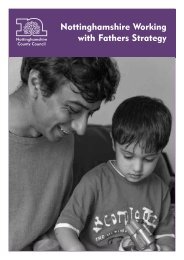
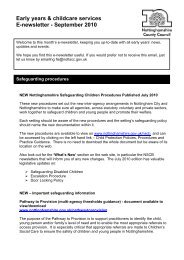
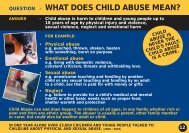

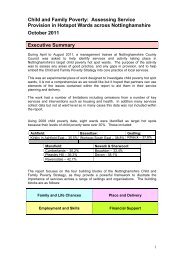
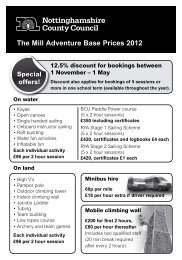
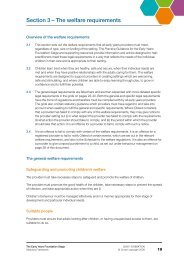
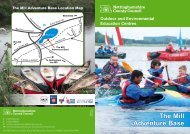


![Every Parent Matters [PDF 463KB] - Nottinghamshire County Council](https://img.yumpu.com/47250686/1/184x260/every-parent-matters-pdf-463kb-nottinghamshire-county-council.jpg?quality=85)
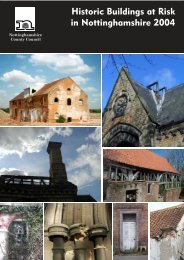

![School Employee Domestic Violence and Abuse Policy [PDF 228KB]](https://img.yumpu.com/46294446/1/184x260/school-employee-domestic-violence-and-abuse-policy-pdf-228kb.jpg?quality=85)
